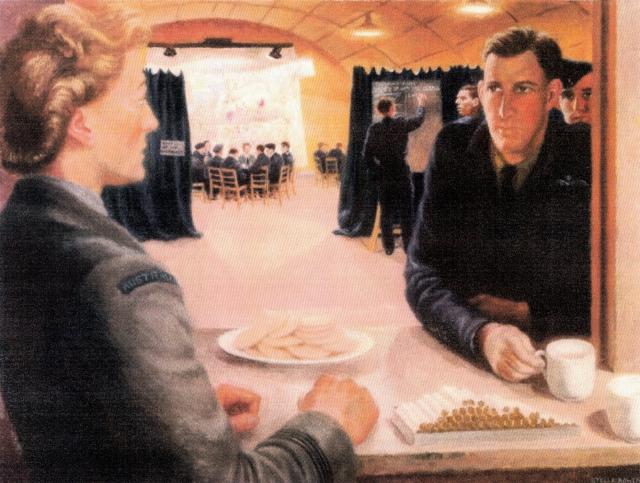In the dark cold and rainy conditions of war-time England in 1944, George Lindenberg had just come back from operations in a Lancaster bomber over Germany, when he was asked to sit for an artist to paint his portrait.
George was stationed at Binbrook, Lincolnshire with 460 Squadron and was selected for this task to have an Australian airman who looked like the typical “Aussie” portrayed on canvas. So, although very tired after 10 hours of combat flying, George reluctantly accepted to sit when he was told the finished portrait would be sent to the Australian War Memorial after the war.
The painting was completed by artist Stella Bowen on D-Day 6 June 1944.
Stella Bowen (1893 – 1947) was appointed by the Australian War Memorial in 1944, one of the earliest women to be appointed. She was famous for her wartime portraits of RAAF pilots, ex-prisoners of war, and military commanders.
One of her art pieces depicting members of No. 460 Avro Lancaster squadron about to go on operations, was depicted on an Australian postage stamp a few years ago.
George Edward Maskell’s story began at the small New England town of Guyra where he was born on the 8 January 1918, as a son to Charles and Janet Lindenberg.
At a very early age, Charles took his small family to the Darling Downs, where they took up residence at Turner’s Creek, just outside the settlement of Dalveen in Queensland.
George received his early education at Dalveen State School where he was given the nickname of “Lindy”, before moving to High School in Warwick, where he was an above-average student completing his education with first-class honours in his final Year 10 cohort.
On leaving school after Year 10, George played tennis, cricket and football as a teenager while employed by Mr J.J. Fidgeon at his sawmill in Thulimbah.
George worked on the machinery maintenance at the mill and was found to be a very capable worker but any further advancement was stymied by the outbreak of World War II in 1939.
After England was under siege in the Battle of Britain, their government called for the Dominion countries to assist in the conflict as a shortage of aircrew was of real concern, so, the British Empire Training Scheme (BETS) was implemented with Australia calling for aircrew enlistments.
On 8 November 1941, George went to Brisbane and enlisted into the Royal Australian Air Force as a trainee pilot. He was immediately posted to No 3 Initial Training School at Sandgate in Brisbane for early training before moving to No 12 Elementary Flying School and later, to No 10 School in Queensland before finally completing his flying course on bombers at Mallala, South Australia.
George obtained his “wings” and was dux of his class with a percentage mark of 100 per cent, thus earning the nickname from his class mates as; “100 per cent Lindy”.
The next chapter in George’s story was in his posting to Bomber Command in England so on 6 March 1943. George and his graduate mates were sent to Canada for further training before reporting to No 460 Bomber Squadron based at Binbrook, in Lincolnshire in England flying Lancaster Bombers attacking Germany.
With a 54 per cent casualty rate it was a daunting task for these young fresh- faced Australians but they did not hesitate to take up the challenge.
George was quickly promoted to Warrant Officer, and later, as an acting Flying Officer as he joined a crew and quickly established himself as a very capable pilot determined to make the most of his tour of 30 combat missions over Germany.
George showed his flying skill in one incident when his aircraft was badly damaged and so he ordered his crew to bail out and continued flying the ill-fated Lancaster and landing it in a cornfield badly damaged, but George uninjured. However, his exceptional flying skills were rewarded later when he was awarded the Distinguished Flying Cross 0n 26th October 1944 and here is how his action was described.
Warrant Officer Lindenberg has completed many operational sorties including attacks on heavily defended targets in Germany. He has at all times displayed great determination and a strong sense of purpose, while his skilful pilotage and devotion to duty in hazardous situations, have been an inspiration to all the squadron. One evening in July 1944, this officer was detailed to attack a target in Caen. Immediately after bombing, his aircraft was severely damaged by anti-aircraft fire and three engines failed. By superb airmanship, executed in the most adverse circumstances, a successful crash landing was accomplished behind the British lines. Such was Warrant officer Lindenberg keenness, that he was able to rejoin his squadron in less than 24 hours, fit for operational duties”.
After a rest from operational duties George and his mates attended a Christmas party while on leave in London in 1944, and there George met a stunning English girl who was a member of the WAAF. Her name was Marlene Brennan from Rainhill, a suburb of Liverpool, and so a war-time romance developed and they became engaged to be married. Although Marlene did make a trip out to Australia in 1947, distance apart for three years caused the marriage to not go ahead. Instead, George ended up marrying Doreen Fay and together they raised four children.
When George returned home at the war’s end in 1945, he began working for the Warwick Gas Company before taking a clerical position in the Warwick Dairy factory in Victoria Street close to his residence there. Later, he moved to further clerical positions in the government Main Roads Department in Warwick, before finally working in the Glengallen Shire offices. It was here that George was stricken by a sudden Heart attack and passed away in March 1981. He now lies at rest along side his loving mother at Eden’s Garden cemetery in Warwick.
George Edward Lindenberg was a true Australian hero as his Distinguished Flying Cross was testimony to that episode of his life. He will forever be remembered for his combat missions, but more so for his portrait that hangs in the Australian War Memorial that will be there for evermore and has been there now for over 80 years. It portrays a typical “Aussie” airman with the determined look that is the real mark of those intrepid young flyers of Bomber Command. As Winston Churchill once said: “The Navy can lose us the war, but only the Air Force can win it. The Fighters are our salvation, but the bombers alone provide the means of victory”.







